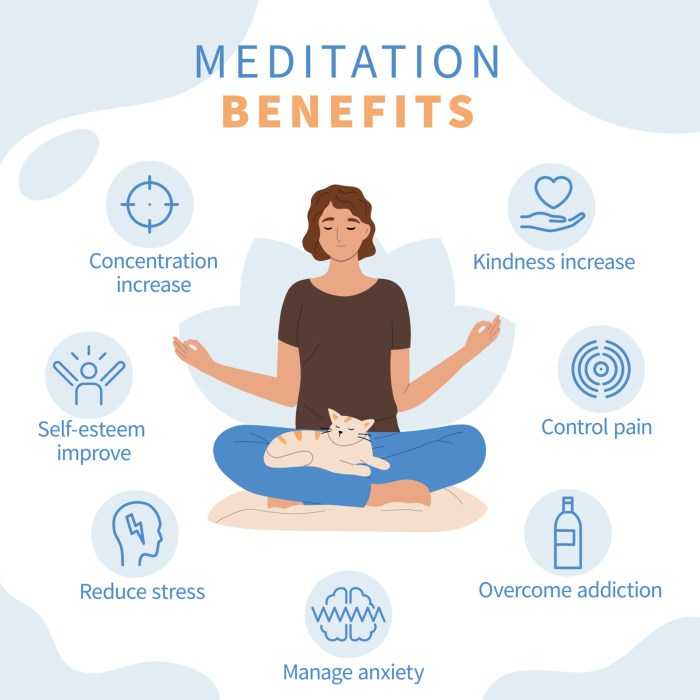Mindfulness meditation sets the stage for this enthralling narrative, offering readers a glimpse into a story that is rich in detail and brimming with originality from the outset. From its ancient roots to its modern applications, this practice holds the key to unlocking inner peace and clarity.
As we delve deeper into the realms of mindfulness meditation, we uncover a world where focus, calm, and self-awareness intertwine to create a transformative experience unlike any other.
Introduction to Mindfulness Meditation

Source: ana-heart.com
Mindfulness meditation is a practice that involves focusing one’s attention on the present moment without judgment. It aims to cultivate awareness of thoughts, emotions, and sensations as they arise, promoting a sense of clarity and inner peace.
The origins of mindfulness meditation can be traced back to ancient Buddhist teachings, particularly in the form of Vipassana or Insight Meditation. Over time, this practice has been adapted and integrated into various secular contexts, including psychology and healthcare.
Benefits of Mindfulness Meditation
- Reduced stress and anxiety levels
- Improved focus and concentration
- Enhanced self-awareness and emotional regulation
- Increased resilience to challenges and setbacks
Differences from Other Types of Meditation
Mindfulness meditation is distinct from other forms of meditation, such as transcendental meditation or loving-kindness meditation, in its emphasis on non-judgmental awareness of the present moment. While some practices may focus on specific mantras or visualizations, mindfulness meditation encourages an open and accepting attitude towards whatever arises in the mind and body.
Techniques and Practices

Source: manhattanmentalhealthcounseling.com
When it comes to mindfulness meditation, there are various techniques and practices that individuals can explore to cultivate a sense of presence and awareness. Here are some common approaches:
Body Scan
- Begin by finding a comfortable position, either sitting or lying down.
- Start by focusing your attention on different parts of your body, starting from your toes and moving up to your head.
- Notice any sensations, tension, or areas of tightness without judgment.
- Breathe into those areas and allow them to relax as you continue to scan your body.
Mindful Breathing
- Find a quiet space where you can sit comfortably with your back straight.
- Focus on your breath, either the sensation of the air entering and leaving your nostrils or the rise and fall of your abdomen.
- When your mind starts to wander, gently bring your focus back to your breath without judgment.
- Continue this practice for a few minutes to start and gradually increase the duration as you become more comfortable.
Guided Meditation vs. Silent Meditation
Guided meditation involves following the instructions and prompts of a teacher or recorded audio to lead you through the practice. This can be beneficial for beginners or individuals who struggle to stay focused on their own. On the other hand, silent meditation involves sitting in silence and focusing on your breath or a mantra without external guidance. Both approaches have their merits, and it’s essential to explore what works best for you.
Tips for Maintaining Focus
- Set aside a dedicated time and space for your meditation practice to minimize distractions.
- Start with shorter sessions and gradually increase the duration as you build your focus and concentration.
- If your mind wanders, gently bring your attention back to the present moment without self-criticism.
- Experiment with different techniques to find what resonates with you and brings you a sense of calm and clarity.
Physical and Mental Health Benefits

Source: upenn.edu
Mindfulness meditation offers a wide range of benefits for both physical and mental well-being. By incorporating mindfulness practices into your daily routine, you can experience a reduction in stress levels, improved sleep quality, better emotional regulation, and even relief from conditions like anxiety and depression.
Impact of Mindfulness Meditation on Stress Reduction
- Practicing mindfulness meditation can help lower cortisol levels, the stress hormone, in the body.
- Regular meditation sessions can promote a sense of calm and relaxation, reducing the impact of daily stressors.
- By focusing on the present moment, mindfulness meditation can shift your attention away from stress-inducing thoughts.
Improvement in Sleep Quality through Mindfulness Meditation
- Mindfulness practices can calm the mind and create a conducive environment for falling asleep.
- Reducing stress and anxiety through meditation can lead to a more restful and uninterrupted sleep.
- Establishing a bedtime meditation routine can signal to the body that it is time to unwind and prepare for sleep.
Connection between Mindfulness Meditation and Emotional Regulation
- Mindfulness meditation helps individuals become more aware of their emotions without judgment, allowing for better regulation.
- By observing emotions as they arise during meditation, one can learn to respond to them in a more balanced and controlled manner.
- Regular practice of mindfulness can lead to increased emotional resilience and a greater ability to manage challenging situations.
Effects of Mindfulness Meditation on Mental Health Conditions
- Research has shown that mindfulness meditation can be effective in reducing symptoms of anxiety and depression.
- Mindfulness practices offer individuals coping mechanisms to deal with overwhelming emotions associated with mental health disorders.
- Integrating mindfulness into therapy has been found to enhance the overall effectiveness of treatment for various mental health conditions.
Integrating Mindfulness Meditation into Daily Life

Source: vecteezy.com
Mindfulness meditation can be seamlessly integrated into daily routines, offering a range of benefits that enhance overall well-being.
Incorporating Mindfulness into Daily Routines
One way to incorporate mindfulness meditation into daily life is by starting the day with a short meditation session. This can help set a positive tone for the day ahead and promote a sense of calm and focus. Additionally, incorporating mindfulness into daily activities such as mindful eating, walking, or even driving can help cultivate a sense of presence and awareness throughout the day.
Enhancing Productivity and Focus
- Practicing mindfulness meditation regularly can help improve focus and concentration, leading to increased productivity in daily tasks.
- By taking short mindfulness breaks throughout the day, individuals can recharge their mental energy and approach tasks with renewed clarity and efficiency.
Staying Consistent with Mindfulness Practice
Setting a consistent schedule for mindfulness meditation can help establish a routine and make it easier to integrate into daily life. Utilizing mindfulness apps or setting reminders can also be helpful tools in maintaining a regular practice.
Improving Relationships and Communication
- Practicing mindfulness can enhance emotional intelligence and empathy, leading to improved relationships with others.
- By staying present and actively listening during conversations, individuals can foster better communication and deeper connections with those around them.
Last Recap

Source: humanoriginproject.com
In conclusion, mindfulness meditation stands as a beacon of tranquility in a fast-paced world, offering individuals a path to self-discovery, emotional balance, and overall well-being. Embrace this practice, and let its profound effects guide you on a journey towards inner harmony and enlightenment.